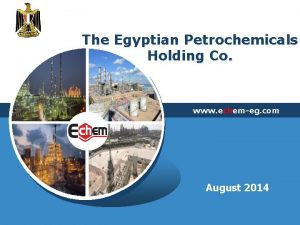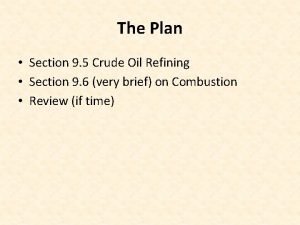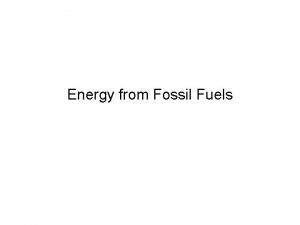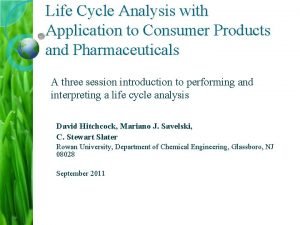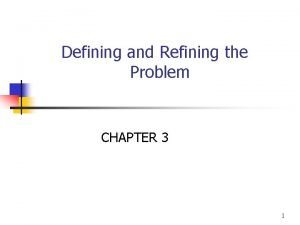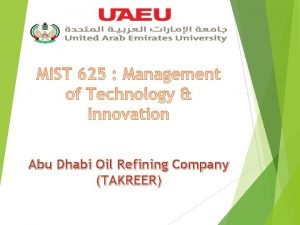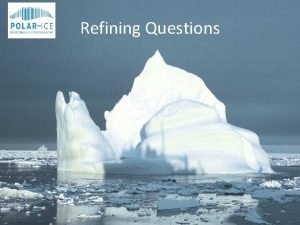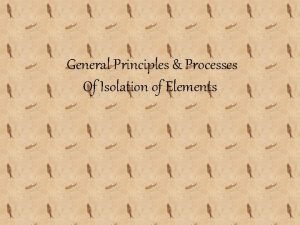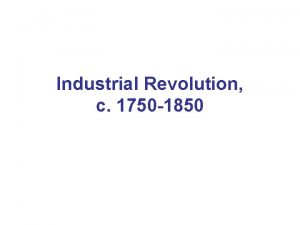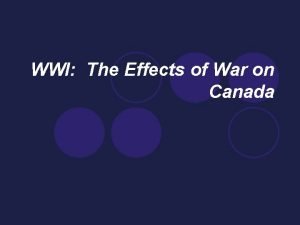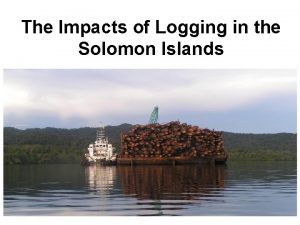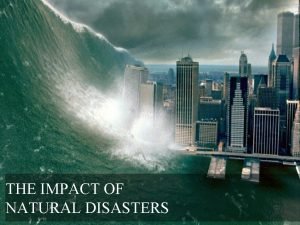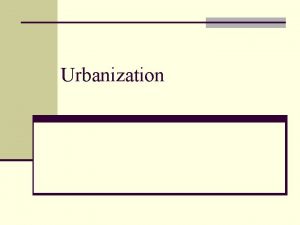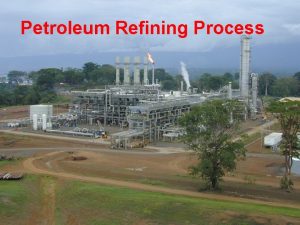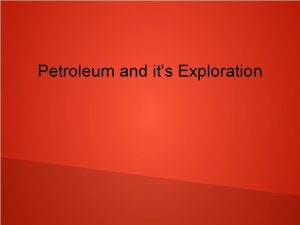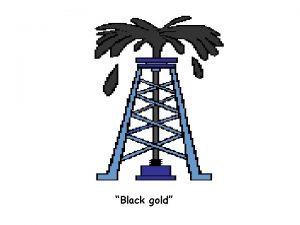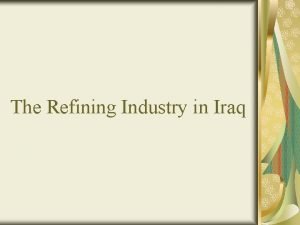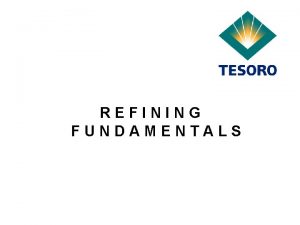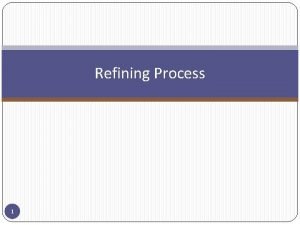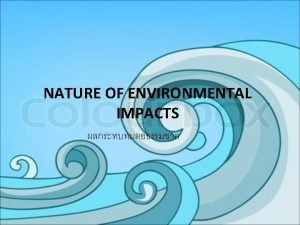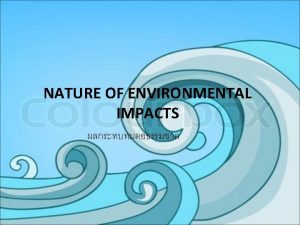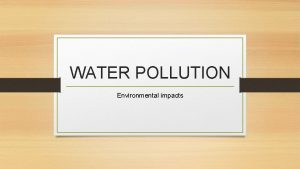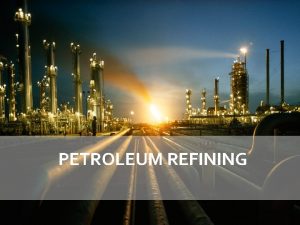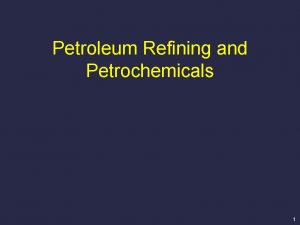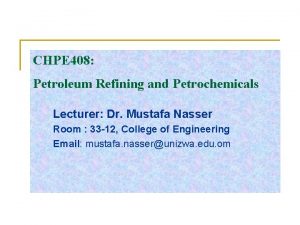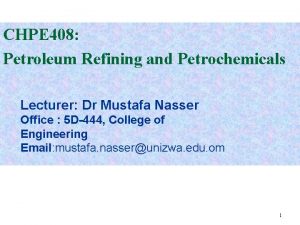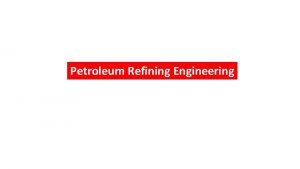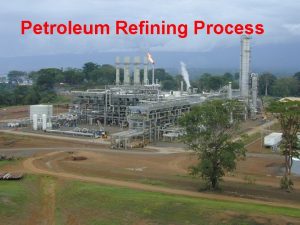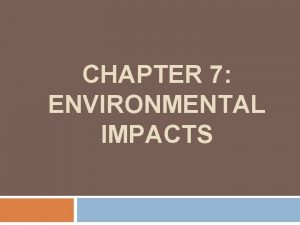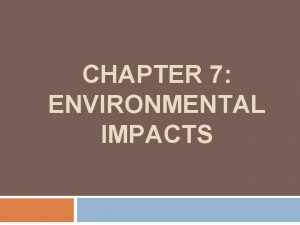Chapter 13 Environmental Impacts of Petroleum Refining Processes


































- Slides: 34

Chapter 13: Environmental Impacts of Petroleum Refining Processes 1

Overview In this chapter, we will briefly study: Ø The different types of pollutants from petroleum refineries and how they are discharged to environment Ø Pollutants discharges from major refinery processes Ø World regulations on pollutants discharges from petroleum refineries Ø Reduction of pollutants discharges to environment and treatment of wastes 2

Some Important Terminologies Process Vent is a point of emission from a unit operation (e. g. , reactor) having a gaseous stream that is discharged to the atmosphere. Fugitive Emissions are emissions of gases or vapors from pressurized equipments due to leaks and various other unintended releases of gases, and is not routed to a pollution control device. Heater Stack Gases are side products of the combustion of fossil fuels used by heaters and furnaces. 3

Air Emissions (Air Pollutants) Ø Heater Stack Gas (CO, NOx, SOx) Ø CO 2 Ø Volatile hydrocarbons (e. g. , Benzene, Toluene, Xylene, Propane and others) Ø Solid particulate (e. g. , metals and dust) AIR EMISSIONS Ø NH 3 Ø H 2 S ØHCl 4

Sources of Air Emissions Combustion Emissions: associated with the burning of fuels in the refinery, including fuels used in the generation of electricity. Equipment Leak Emissions (Fugitive Emissions): released through leaking valves, pumps, or other process devices. They are primarily composed of volatile compounds such as ammonia, benzene, toluene, propylene, xylene, and others. Process Vent Emissions: typically include emissions generated during the refining process itself. Gas streams from all refinery processes contain varying amounts of refinery fuel gas , hydrogen sulfide and ammonia. 5

Water Effluents (Water Pollutants) Ø Oil Ø H 2 S ØNH 3 ØPhenols ØSuspended and dissolved solids ØChlorides ØMercaptans ØAlkalines ØBOD (Biochemical Oxygen Demand) ØCOD (Chemical Oxygen Demand) ØCynides ØH 2 SO 4 ØAmines ØHeavy metals Approximately 3. 5 -5 cubic meters of wastewater per ton of crude are generated. 6

BOD (Biochemical Oxygen Demand) BOD= amount of oxygen consumed by microorganisms (e. g. , bacteria) to utilize organic wastes as food and/or energy. From BOD we can estimate the amount of organic wastes in wastewater Example: 7

COD (Chemical Oxygen Demand) COD= amount of oxygen required to fully oxidize organic wastes in wastewater. From COD we can estimate the amount of organic wastes in wastewater Example: 8

Sources and Types of Wastewater Produced in Refineries ØCooling Water: which normally does not come into contact with oil streams and contains less contaminants than process wastewater. It may contain chemical additives used to prevent biological growth in heat exchanger pipes. ØProcess Wastewater: that has been contaminated by direct contact with oil accounts for a significant portion of total refinery wastewater. ØSurface Water Runoff: is generated intermittently (either by rainfall or human) and may contain constituents from spills to the surface, leaks in equipment and materials in drains. 9

Solid Wastes Refineries generate solid wastes and sludges ranging from 3 to 5 kg per ton of crude processed, 80% of this sludges may be considered hazardous because of the presence of harmful organics and heavy metals. 10

Residual Wastes Ø Most refinery residuals are in the form of sludge, spent caustics, spent process catalysts, and incinerator ash. ØThese residuals could be classified as follows: § Non-hazardous Residuals: are incinerated, landfilled or regenerated to provide products that can be sold off-site or returned for re-use at a refinery. § Hazardous Wastes: Listed hazardous wastes include oily sludge, leads tank bottom corrosion solids and wastes from the cleaning of heat exchanger bundles. § Toxic Chemicals: These are very dangerous materials that require extreme handling care. Many toxic chemicals are produced/used in large quantities by refineries. 11

Types and Sources of Residual Wastes Crude oil/desalted sludge: Contains iron rust, clay, sand, metals, emulsified oil and wax. Coke dust: Contains carbon particles and hydrocarbons Spent catalysts: May contain metals, fine particles, phosphoric acid, and/or alumina silicate. Neutralized alkylation sludge: Contains sulfuric acid or calcium fluoride and hydrocarbons. Heat exchanger sludge: Contains oil, metals and suspended solids Tank bottom sludge: Contains iron rust, clay, sand, metal, emulsified oil and wax. 12

Desalting Purpose of Desalting: remove corrosive salts along with some of the metals and suspended solids from crude oil before processing. Environmental impact of Desalting: Air Emissions: CO, SOx, NOx, particulates and fugitive emissions (hydrocarbons). Effluent to Water: Oil, H 2 S, NH 3, phenol, high levels of suspended solids, dissolved solids and high BOD. Amount of wastewater produced = 2. 1 Gal/Bbl crude oil processed. 1 Bbl= 31 Gal Residual waste generated: Sludge contains salts, iron rust, clay, sand, 13 metals, emulsified oil and wax.

Distillation Purpose of Distillation: To separate the ingredients of crude oil into several valuable products. Environmental impact of Distillation: Air Emissions: CO, SOx, NOx, and particulates. Vent and fugitive emissions (hydrocarbons). Effluent to Water: Oil, H 2 S, NH 3, suspended solids, chlorides, mercaptans, phenol and alkalines. Amount of wastewater produced= 26 Gal/Bbl crude oil processed Residual waste generated: Typically little or no residual waste generated. 14

Visbreaking Purpose of Visbreaking: To produce lighter (more valuable) products from heavy (residual) feedstocks. Environmental impact of Visbreaking : Air Emissions: CO, SOx, NOx, and particulates. Vents and fugitive emissions (hydrocarbons). Effluent to Water: Oil, H 2 S, NH 3, phenol, suspended solids, alkalines, BOD and COD. Amount of wastewater produced= 2. 0 Gal/Bbl crude oil processed Residual waste generated: Typically little or no residual waste generated. 15

Coking Purpose of Coking: To produce distillate naphtha and gas oils from heavy residuum. Environmental impact of Coking: Air Emissions: CO, SOx, NOx, and particulates. Vents and fugitive emissions (hydrocarbons). Decoking emissions (hydrocarbons and particulates). Effluent to Water: H 2 S, NH 3, suspended solids, alkalines and COD. Amount of wastewater produced= 1. 0 Gal/Bbl crude oil processed Residual waste generated: Coke dust (carbon particles and hydrocarbons). 16

Catalytic Cracking Purpose of Catalytic Cracking: To upgrade some refinery stocks to more valuable products through catalytic reactions. Environmental impact of Catalytic Cracking: Air Emissions: CO, SOx, NOx, and particulates. Vents and fugitive emissions (hydrocarbons). Effluent to Water: High levels of oil, H 2 S, NH 3, suspended solids, alkalines, phenols, cyanides, BOD and COD. Amount of wastewater produced= 1. 0 -2. 0 Gal/Bbl crude oil processed Residual waste generated: Spent catalyst, which may contain hydrocarbons, metals and/or solid particles 17

Alkylation Purpose of Alkylation is used for the production of higher molecular weight isoparaffins from the reaction of low molecular weight olefins with an isoparaffin in the presence of either sulfuric or hydrofluoric acid. Environmental impact of Alkylation: Air Emissions: CO, SOx, NOx, and particulates. Vents and fugitive emissions (hydrocarbons). Effluent to Water: H 2 S, dissolved and suspended solids, acids (such as sulfuric acid) and COD. Residual waste generated: Neutralized alkylation sludge (contains hydrocarbons, sulfuric acid or calcium chloride). 18

Isomerization Purpose of Isomerization is to convert straight-chain paraffins into isomers that have higher octane numbers. Environmental impact of Isomerization: Air Emissions: CO, SOx, NOx, and particulates. Vents and fugitive emissions (hydrocarbons). Effluent to Water: Chloride salts, caustic wash and relatively low amounts of H 2 S and NH 3 Residual waste generated: Calcium chloride sludge. 19

Polymerization Purpose of Polymerization is a catalytic process to convert low-boiling olefins into gasoline blending stocks Environmental impact of Polymerization: Air Emissions: H 2 S from caustic washing. Effluent to Water: Mercaptans, caustic wash, alkalines, H 2 S and NH 3 Residual waste generated: Spent catalyst containing phosphoric acid. 20

Catalytic Reforming Purpose of Catalytic Reforming in catalytic reforming, the hydrocarbon molecular structures are rearranged to form higher-octane motor gasoline. Environmental impact of Catalytic Reforming: Air Emissions: CO, SOx, NOx, HCl, and particulates. Vents and fugitive emissions (hydrocarbons). Effluent to Water: High levels of oil, suspended solids, COD and relatively low amount of H 2 S. Amount of wastewater produced= 6. 0 Gal/Bbl crude oil processed Residual waste generated: Spent catalyst 21

Dewaxing Purpose of Dewaxing is to lower cloud and pour points by removing waxes from refinery feedstocks or products using organic solvents. Environmental impact of Dewaxing: Air Emissions: Fugitive solvents Effluent to Water: Oil and organic solvents. Residual waste generated: Little or no residual wastes generated 22

Propane Deasphalting Purpose of Propane Deasphalting is to produce asphalt from lube feedstocks and also to increase gas oil yield from crude. Environmental impact of Propane Deasphalting: Air Emissions: CO, SOx, NOx, HCl, hydrocarbons and particulates. Fugitive propane. Effluent to Water: Oil and organic solvents. Residual waste generated: Little or no residual wastes generated 23

Blending Purpose of Blending is to allocate the available blending components in such a way as to meet product demands and specifications at the least cost and maximum possible profit. Environmental impact of Propane Blending: Air Emissions: Fugitive emissions (hydrocarbons) Effluent to Water: Little or no wastewater generated Residual waste generated: Little or no residual wastes generated 24

Heat Exchanger Cleaning Purpose of Heat Exchanger Cleaning is to remove foulings from the inside surfaces of heat exchangers. Environmental impact of Heat Exchanger Cleaning: Air Emissions: Periodic fugitive emissions (hydrocarbons) Effluent to Water: Oily wastewater generated Residual waste generated: Heat exchanger sludge (contains oil, metals and suspended solids) 25

Storage Tanks Purpose of Storage Tanks is to store refinery feedstocks and products. Environmental impact of Storage Tanks: Air Emissions: Fugitive emissions (hydrocarbons) Effluent to Water: Water drained from tanks contaminated with tank contents. Residual waste generated: Tank bottom sludge (contains iron rust, metals, emulsified oil and wax) 26

World General Regulations on Discharges from Refineries The World Bank, has established emission levels for the design and operation of refineries, although country legislation should be accomplished. The guidelines given below present emissions levels normally acceptable to the World Bank Group. Water Effluents from the Gas Emissions from the Petroleum Industry (mg/m 3 crude processed) Petroleum Industry(g/m 3 crude processed) (Total Suspended Solid) Solid Wastes Generation of sludges should be minimized to 0. 3 kg per ton of crude processed, with a maximum of 0. 5 kg per ton of crude processed. 27

Reduction of Air Emissions Preserving air quality around a refinery involves controlling the gas and hydrocarbon vapor emissions to the atmosphere. Reduction of CO Emissions: through complete burning of CO to CO 2 and then using CO 2 capture and sequestration (or biological) methods to dispose CO 2. Preventing H 2 S Emissions: by converting it into elemental sulfur Reduction of SOx Emissions: through sulfur recovery from tail gases in high-efficiency sulfur recovery units Reduction of NOx Emissions: through converting it to less harmful and useful chemicals such as NH 3 and N 2 28

Reduction of Air Emissions. . Continued Reduction of NH 3 Emissions: By converting it to useful chemicals such as urea. Minimization of fugitive emissions of hydrocarbons and organic solvents: Through 1. Proper design with regular maintenance of refinery equipments. 2. By installing floating roofs in storage tanks to prevent evaporation and so that there is no space for vapor to gather in the tanks. 3. Vapour recovery system - absorbed back into the product stream. 4. Prevent leakage in pumps and valves Prevention of particulate emissions: through removal of particulates from gases (by, for example, filtration) and dispose the 29 particulates appropriately.

Wastewater Treatment Refinery wastewater treatment plants are integrated systems that use both primary and secondary treatment. Oil water separator Settling pond for sedimentation. Also known as settling pond or decant pond. 30

Primary Treatment Primary treatment: Used to separate oil and solids from water in two stages. n. First stage: API oil-water separator based on differences in specific gravities. Process: allow sufficient time for free oil to float to the surface and be skimmed off, while solids settle to the bottom of the unit and are removed by mechanical scraping and depositing of the sludge into a collection hopper. Second stage: relies on physical or chemical methods to separate emulsified oils and fine particles from the wastewater: n. Physical methods are typically a series of settling ponds designed to have long retention times to allow settling. n. Chemicals such as ferric hydroxide or aluminum hydroxide are used to coagulate impurities into a froth or sludge, which can be skimmed off the surface. 31

Secondary Treatment n Biological treatment: Dissolved oil and other organic pollutants may be consumed biologically. Biological treatment may require oxygen. Treatment can be done through different techniques: • Activated sludge units • Trickling filters • Rotating biological contactors. Polishing Some refineries employ it as an additional stage of wastewater treatment to meet discharge limits. • Activated carbon • Anthracite coal • Sand Generates bio-mass waste which is treated anaerobically. 32

Solid Waste Treatment Sludge treatment use bioremediation or solvent extraction, followed by combustion of the residues or using it as asphalt additive. The residue could require stabilization before disposal to reduce the leachability of toxic metals. 33

End of Environmental Impacts of Petroleum Refining Processes 34
 Egyptian petrochemicals holding company
Egyptian petrochemicals holding company Crude oil refining process
Crude oil refining process Impact of tidal energy on environment
Impact of tidal energy on environment What are the environmental impacts of fossil fuels
What are the environmental impacts of fossil fuels Negative impacts of environmental technology
Negative impacts of environmental technology Environmental impacts
Environmental impacts Concurrent processes are processes that
Concurrent processes are processes that From an academic perspective research is relevant if:
From an academic perspective research is relevant if: Takreer company
Takreer company Refining discussion techniques
Refining discussion techniques Short note on vapour phase refining
Short note on vapour phase refining Mh 605
Mh 605 What is technology
What is technology Positive and negative impacts of materials technology
Positive and negative impacts of materials technology Negative social impacts of tourism
Negative social impacts of tourism Educate
Educate When was the loom invented
When was the loom invented What impact did the gaa have on irish life
What impact did the gaa have on irish life Impacts of the haitian revolution
Impacts of the haitian revolution Negative impacts of materials technology
Negative impacts of materials technology Negative social impacts of tourism
Negative social impacts of tourism Positive impacts of tourism in glasgow
Positive impacts of tourism in glasgow Positive impacts of information technology
Positive impacts of information technology Consequences of inflation
Consequences of inflation Industrial revolution effects
Industrial revolution effects Enclosure movement industrial revolution
Enclosure movement industrial revolution Advantages of commercialisation
Advantages of commercialisation Effects of ww1
Effects of ww1 Social impact of ict
Social impact of ict Impact of logging on agriculture production
Impact of logging on agriculture production Social impacts of natural disasters
Social impacts of natural disasters Archetypal narrative elements in the pardoner's tale
Archetypal narrative elements in the pardoner's tale What are the social impacts of information technology
What are the social impacts of information technology What is intellectual merit
What is intellectual merit Urban hearths
Urban hearths
